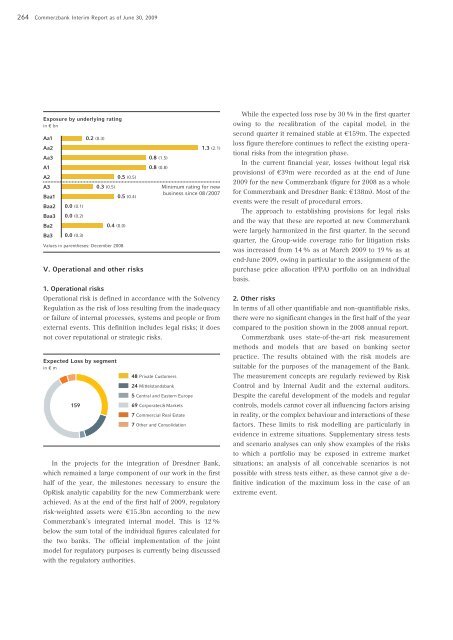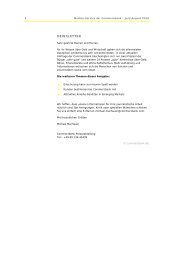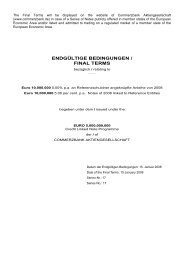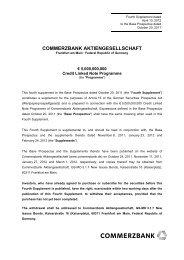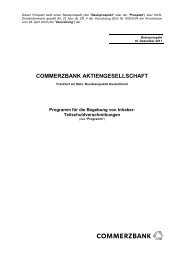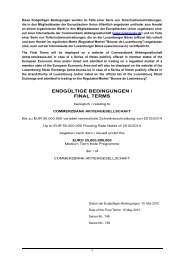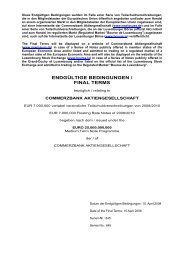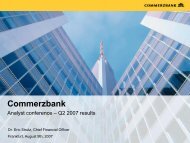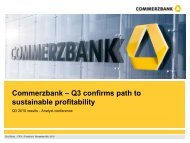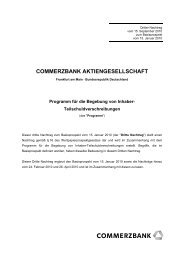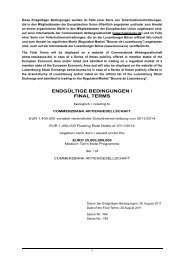COMMERZBANK AKTIENGESELLSCHAFT
COMMERZBANK AKTIENGESELLSCHAFT
COMMERZBANK AKTIENGESELLSCHAFT
Create successful ePaper yourself
Turn your PDF publications into a flip-book with our unique Google optimized e-Paper software.
264 Commerzbank Interim Report as of June 30, 2009<br />
Exposure by underlying rating<br />
in € bn<br />
Aa1<br />
Aa2<br />
Aa3<br />
A1<br />
A2<br />
A3<br />
Baa1<br />
Baa2<br />
Baa3<br />
Ba2<br />
Ba3<br />
0.0 (0.1)<br />
0.0 (0.2)<br />
0.0 (0.3)<br />
0.2 (0.3)<br />
0.3 (0.5)<br />
0.4 (0.0)<br />
Values in parentheses: December 2008<br />
0.5 (0.5)<br />
0.5 (0.4)<br />
V. Operational and other risks<br />
0.8 (1.5)<br />
0.8 (0.8)<br />
1.3 (2.1)<br />
1. Operational risks<br />
Operational risk is defined in accordance with the Solvency<br />
Regulation as the risk of loss resulting from the inadequacy<br />
or failure of internal processes, systems and people or from<br />
external events. This definition includes legal risks; it does<br />
not cover reputational or strategic risks.<br />
Expected Loss by segment<br />
in € m<br />
159<br />
48 Private Customers<br />
24 Mittelstandsbank<br />
Minimum rating for new<br />
business since 08 /2007<br />
5 Central and Eastern Europe<br />
69 Corporates & Markets<br />
7 Commercial Real Estate<br />
7 Other and Consolidation<br />
In the projects for the integration of Dresdner Bank,<br />
which remained a large component of our work in the first<br />
half of the year, the milestones necessary to ensure the<br />
OpRisk analytic capability for the new Commerzbank were<br />
achieved. As at the end of the first half of 2009, regulatory<br />
risk-weighted assets were €15.3bn according to the new<br />
Commerzbank’s integrated internal model. This is 12 %<br />
below the sum total of the individual figures calculated for<br />
the two banks. The official implementation of the joint<br />
model for regulatory purposes is currently being discussed<br />
with the regulatory authorities.<br />
While the expected loss rose by 30 % in the first quarter<br />
owing to the recalibration of the capital model, in the<br />
second quarter it remained stable at €159m. The expected<br />
loss figure therefore continues to reflect the existing operational<br />
risks from the integration phase.<br />
In the current financial year, losses (without legal risk<br />
provisions) of €39m were recorded as at the end of June<br />
2009 for the new Commerzbank (figure for 2008 as a whole<br />
for Commerzbank and Dresdner Bank: €138m). Most of the<br />
events were the result of procedural errors.<br />
The approach to establishing provisions for legal risks<br />
and the way that these are reported at new Commerzbank<br />
were largely harmonized in the first quarter. In the second<br />
quarter, the Group-wide coverage ratio for litigation risks<br />
was increased from 14 % as at March 2009 to 19 % as at<br />
end-June 2009, owing in particular to the assignment of the<br />
purchase price allocation (PPA) portfolio on an individual<br />
basis.<br />
2. Other risks<br />
In terms of all other quantifiable and non-quantifiable risks,<br />
there were no significant changes in the first half of the year<br />
compared to the position shown in the 2008 annual report.<br />
Commerzbank uses state-of-the-art risk measurement<br />
methods and models that are based on banking sector<br />
practice. The results obtained with the risk models are<br />
suitable for the purposes of the management of the Bank.<br />
The measurement concepts are regularly reviewed by Risk<br />
Control and by Internal Audit and the external auditors.<br />
Despite the careful development of the models and regular<br />
controls, models cannot cover all influencing factors arising<br />
in reality, or the complex behaviour and interactions of these<br />
factors. These limits to risk modelling are particularly in<br />
evidence in extreme situations. Supplementary stress tests<br />
and scenario analyses can only show examples of the risks<br />
to which a portfolio may be exposed in extreme market<br />
situations; an analysis of all conceivable scenarios is not<br />
possible with stress tests either, as these cannot give a definitive<br />
indication of the maximum loss in the case of an<br />
extreme event.


